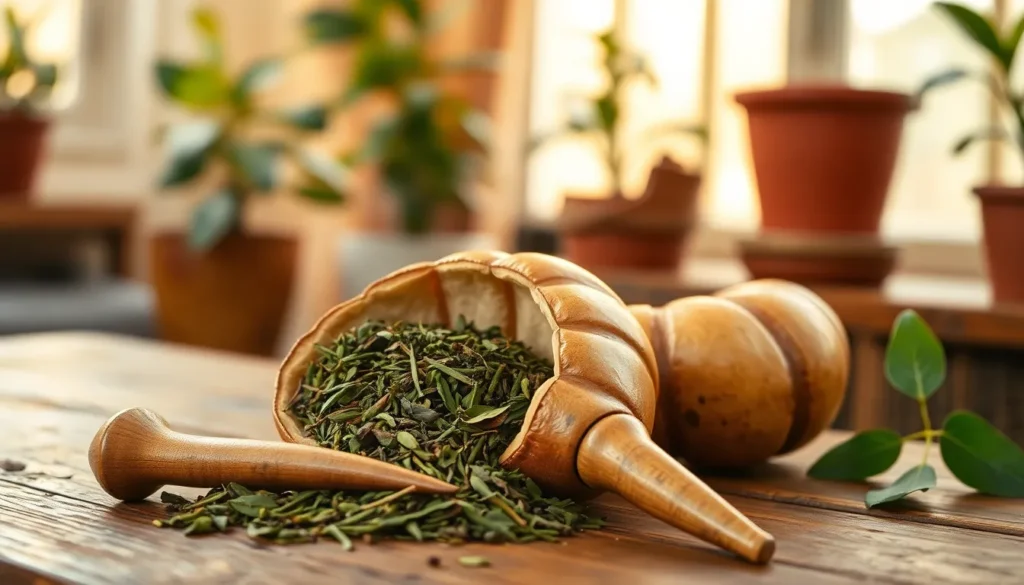We’ve discovered one of South America’s best-kept secrets: yerba mate tea. This energizing beverage has fueled gauchos and office workers alike for centuries across Argentina, Uruguay, and Paraguay. Unlike coffee’s quick jolt, yerba mate delivers sustained energy that’ll keep you focused without the crash.
What makes yerba mate special isn’t just its caffeine content – it’s packed with vitamins, minerals, and antioxidants that coffee simply can’t match. The traditional brewing method using a gourd and bombilla creates a ritual that transforms your daily tea break into a mindful experience.
We’ll show you how to brew authentic yerba mate that captures its earthy, complex flavors perfectly. Whether you’re seeking a healthier alternative to coffee or want to explore this fascinating South American tradition, mastering yerba mate brewing will revolutionize your morning routine and boost your energy naturally.
What You’ll Need
Brewing authentic yerba mate requires exact tools and ingredients that honor this traditional South American practice. We’ll guide you through the essential items to create the perfect cup of this energizing beverage.
Essential Equipment
The foundation of proper yerba mate brewing lies in using traditional equipment designed specifically for this purpose. A gourd (mate cup) serves as the vessel for brewing and drinking your tea. Natural gourds made from calabash provide the most authentic experience, though modern ceramic or wooden alternatives work well for beginners.
The bombilla acts as both straw and filter, featuring a perforated metal bulb at the bottom that strains the yerba leaves while you drink. Stainless steel bombillas offer durability and easy cleaning, making them ideal for daily use.
You’ll also need a thermos or insulated water bottle to maintain optimal water temperature throughout your mate session. A reliable thermometer ensures you heat water to the precise temperature range of 160-180°F, preventing bitter flavors that result from boiling water.
Ingredients
Yerba mate leaves form the heart of your brewing experience. We recommend starting with traditional loose-leaf yerba mate from reputable South American brands like La Merced, Taragui, or Cruz de Malta. These brands offer authentic flavors that reflect centuries of cultivation expertise.
Filtered water provides the cleanest foundation for your tea. Tap water with high mineral content or chlorine can mask the subtle earthy flavors that make yerba mate distinctive.
Optional ingredients can enhance your brewing experience based on personal preference. Fresh mint leaves add cooling properties, while orange peel contributes citrus brightness. Honey or raw sugar can soften the naturally bitter profile for those new to yerba mate.
Preparing Your Gourd and Bombilla
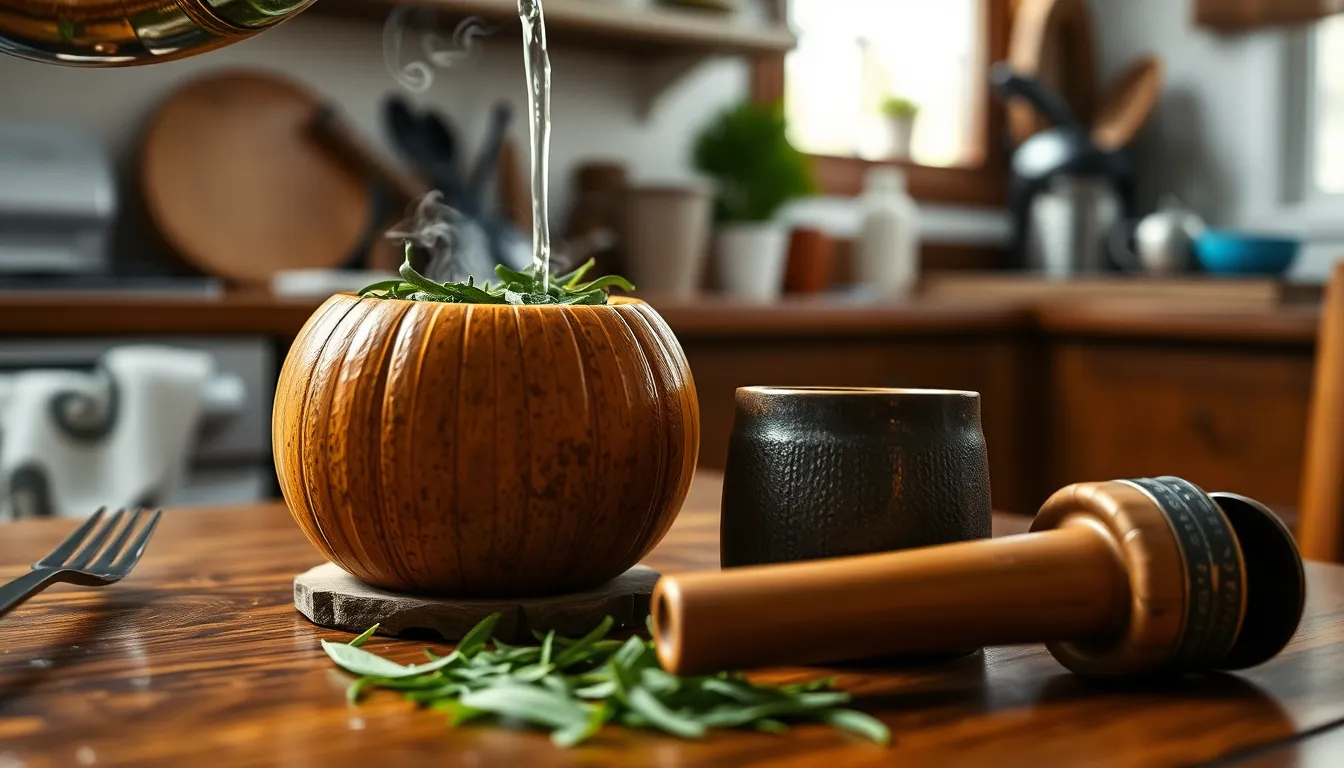
Before we can enjoy authentic yerba mate tea, we need to properly prepare our brewing equipment. These essential preparation steps ensure optimal flavor and extend the life of our traditional tools.
Seasoning a New Gourd
Natural gourds require proper curing before their first use to prevent them from absorbing unwanted flavors from the yerba mate. We begin by filling our new gourd completely with loose yerba mate leaves and adding hot water to create a concentrated infusion. This mixture should sit for several hours or overnight to allow the yerba mate to penetrate the gourd’s porous walls.
We repeat this seasoning process multiple times over several days to ensure our gourd is fully prepared. Each curing session builds up a protective layer that will enhance the flavor of future brews. After each seasoning round, we empty the gourd and rinse it gently with warm water before allowing it to air dry completely.
Cleaning Your Bombilla
Our bombilla serves as both straw and filter, making proper maintenance crucial for the best yerba mate experience. After each brewing session, we rinse the bombilla thoroughly with warm water to remove any lingering yerba mate particles from its intricate filter system.
We occasionally soak our bombilla in hot water for deeper cleaning, especially when we notice any buildup affecting the flow. This thorough cleaning process removes oils and residue that could impact the taste of our next cup. Between uses, we store our bombilla in a dry place to prevent any moisture related issues that could affect its performance.
Traditional Brewing Method
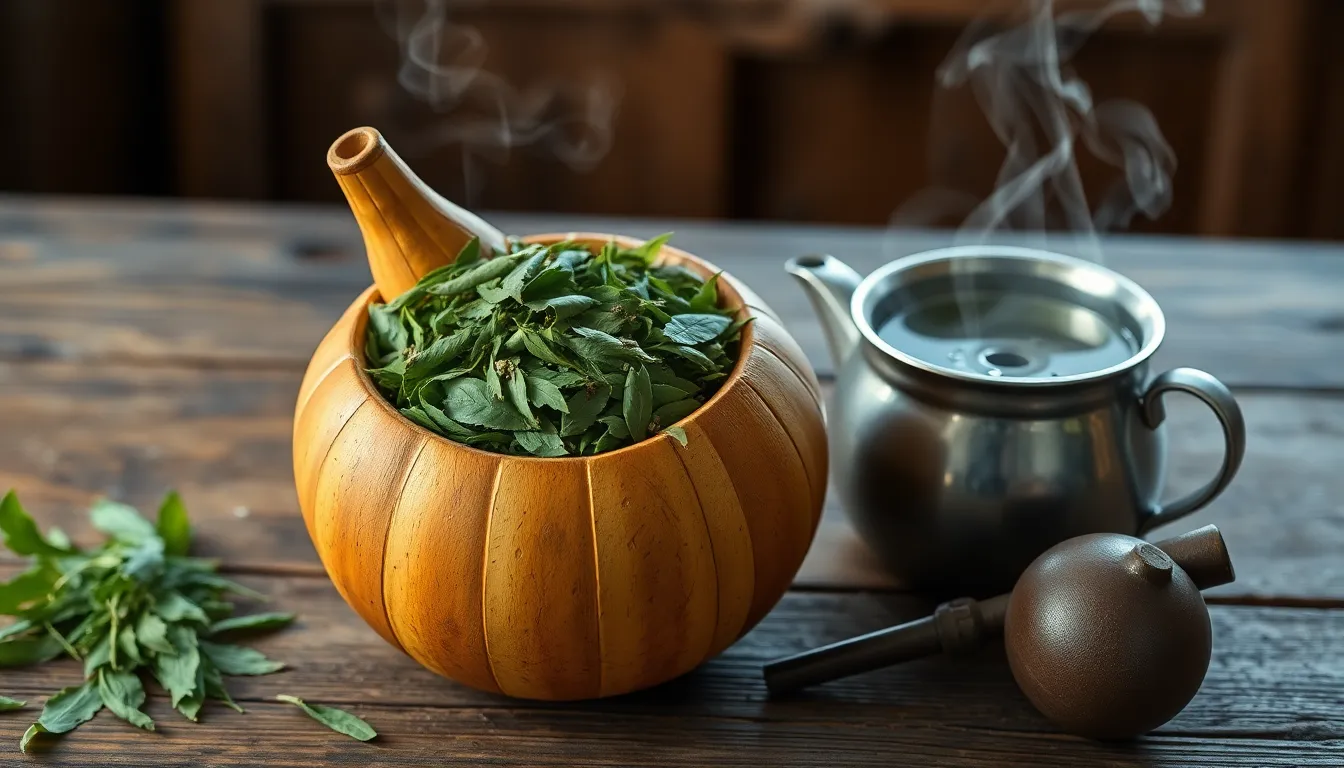
We’ll guide you through the authentic yerba mate brewing process that has been perfected over generations. This method creates the perfect balance of flavor and strength while honoring the cultural traditions of South America.
Step-by-Step Instructions
1. Fill the Gourd
We start by filling our gourd about one-third full with loose yerba mate leaves. The leaves should occupy roughly 30-35% of the cup’s volume for optimal strength.
2. Create the Mountain
We tilt the gourd at a 45-degree angle so the yerba mate leans to one side. This creates a sloped surface of dry leaves on one side and an empty space on the other where we’ll pour our water.
3. Moisten with Cold Water
We pour a small amount of cold water into the empty space to gently moisten the leaves. This step protects the yerba from being scorched by hot water and allows the leaves to absorb moisture gradually.
4. Add Hot Water
We pour hot water at 70-80°C (158-176°F) into the empty space we created. The water should never touch all the leaves directly to preserve their flavor and prevent bitterness.
5. Insert the Bombilla
We place our metal straw gently at the bottom of the empty space and keep it steady throughout the drinking session. The bombilla should remain in the same position once placed.
6. Enjoy and Refill
We sip the mate through the bombilla and refill the gourd with hot water multiple times. Each refill maintains the flavor profile and allows us to enjoy the mate for an extended period.
Temperature Guidelines
| Temperature Range | Celsius | Fahrenheit | Result |
|---|---|---|---|
| Too Hot | Above 80°C | Above 176°F | Bitter and harsh |
| Optimal | 70-80°C | 158-176°F | Balanced flavor |
| Too Cool | Below 70°C | Below 158°F | Weak extraction |
We never use boiling water as it scorches the leaves and creates an unpleasantly bitter taste. Our best practice involves bringing water to a boil then letting it cool for 5 minutes before pouring. We can also stop heating just before the water reaches a full boil when small bubbles begin forming at the bottom of the kettle.
Proper Pouring Technique
We always begin with cold water to create our initial moisture layer. This technique protects the delicate yerba mate leaves from thermal shock and preserves their complex flavor compounds.
Our pouring motion focuses on the empty space rather than directly onto the leaf pile. We maintain this approach throughout multiple refills to keep the dry leaves intact on one side of the gourd. The gentle stream of water should flow steadily without creating turbulence that might disturb the leaf arrangement.
We refill the gourd multiple times during our drinking session while maintaining the same pouring angle and location. This method ensures consistent flavor extraction and prevents the premature breakdown of the yerba mate structure.
Alternative Brewing Methods
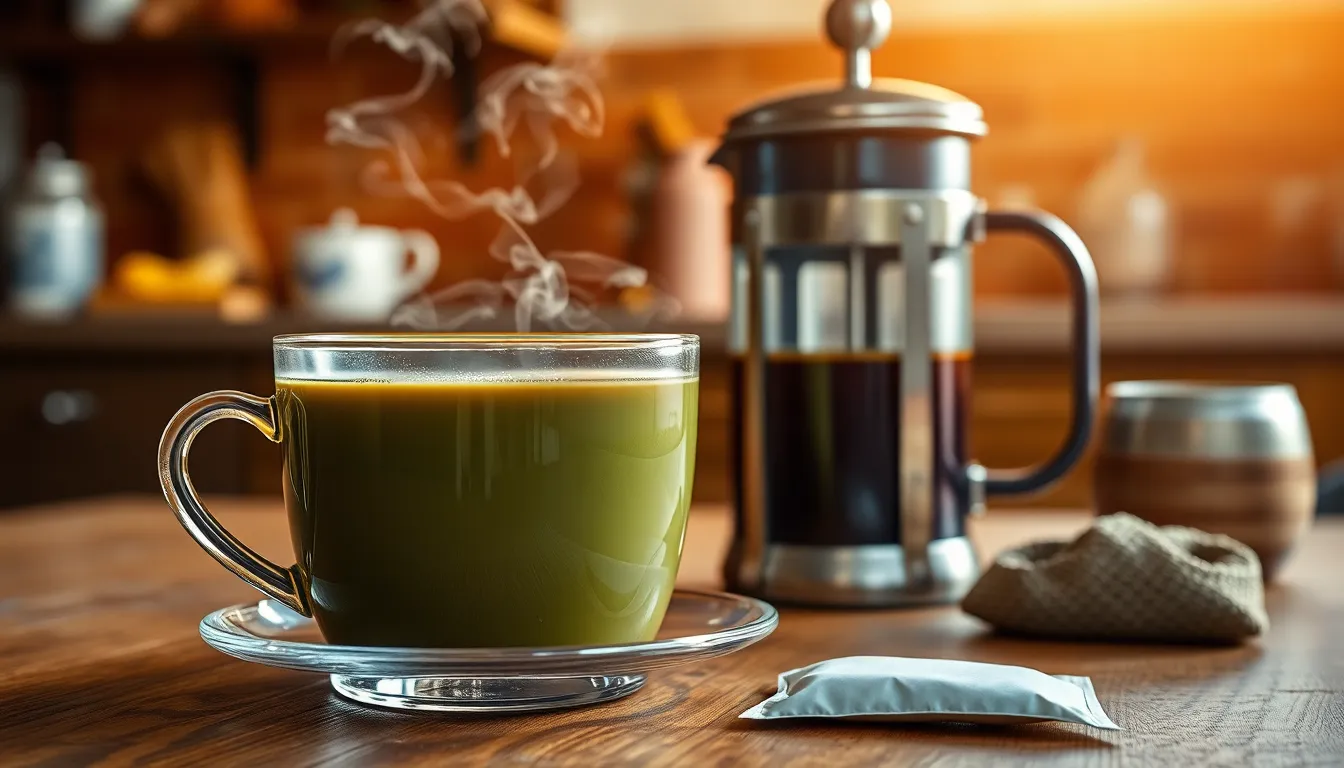
While the traditional gourd and bombilla method offers the most authentic experience, modern brewing techniques can make yerba mate more accessible for everyday enjoyment. These methods maintain the tea’s distinctive flavor profile while adapting to contemporary lifestyles.
French Press Method
We recommend the French press approach for those seeking a robust yerba mate brew with minimal equipment. Add three spoonfuls of loose leaf yerba mate to your French press and begin by pouring cold water over the leaves to create an initial moisture layer. Fill the press with hot water heated to 80-100°F, which is significantly cooler than typical coffee brewing temperatures. Allow the mixture to steep for exactly two minutes to extract optimal flavor without creating excessive bitterness. Press the plunger down slowly and steadily to separate the grounds from the liquid. Pour immediately into your favorite mug and savor the full-bodied taste that this method produces.
Tea Bag Method
The tea bag method provides the quickest path to enjoying yerba mate without any specialized equipment. Place one yerba mate tea bag in your standard coffee mug or teacup for convenient preparation. Heat water to the ideal temperature range of 158-176°F, ensuring you maintain the same temperature guidelines as traditional brewing. Pour the heated water directly over the tea bag and let it steep for 3-5 minutes depending on your desired strength preference. Remove the tea bag gently to avoid tearing and releasing bitter compounds. This method works perfectly for office settings or when traveling.
Cold Brew Yerba Mate
Cold brewing creates a smooth and mellow yerba mate concentrate that eliminates any potential bitterness. Combine loose leaf yerba mate with cold filtered water in a glass jar or airtight container using a ratio that suits your taste preferences. Refrigerate the mixture for 8-12 hours, allowing the extended steeping time to extract the tea’s beneficial compounds gradually. Strain the concentrate through a fine mesh strainer or cheesecloth to remove all plant material. Serve the cold brew over ice cubes for a refreshing beverage that maintains yerba mate’s energizing properties without the heat.
Serving and Drinking Etiquette
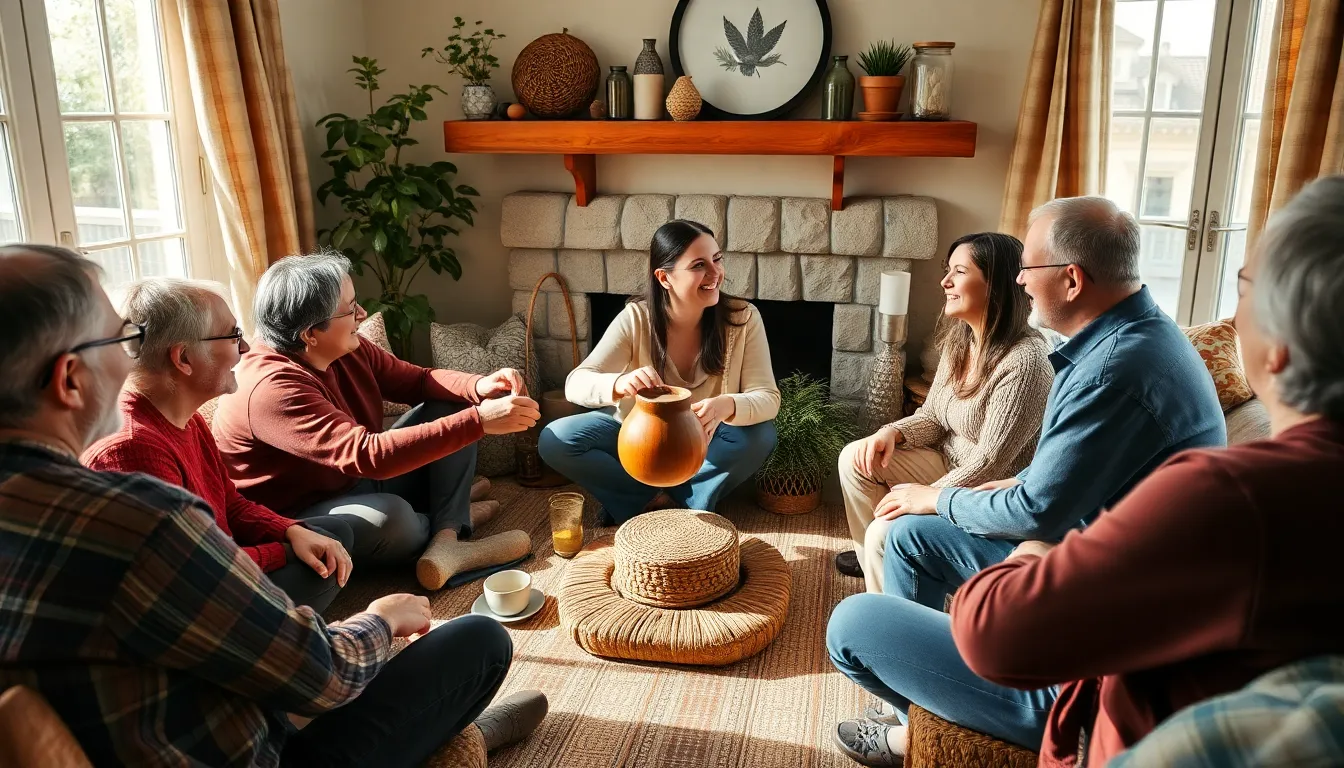
Now that we understand the brewing process let’s explore the cultural customs that make yerba mate such a meaningful experience. These time-honored traditions transform a simple beverage into a ritual of connection and respect.
Traditional Sharing Ritual
Yerba mate creates bonds through its unique communal drinking tradition that has been practiced for centuries across South America. We begin by having the host prepare the gourd and take the first sip to ensure the mate is properly brewed and not too bitter for guests.
The gourd travels in a clockwise direction around the circle with each person receiving their turn. We drink through the bombilla until we hear the distinctive gurgling sound that signals the water is finished. Each participant returns the empty gourd to the host rather than passing it directly to the next person.
Our host refills the gourd with fresh hot water and passes it to the next person in sequence. Nobody should move the bombilla or add sugar unless specifically offered by the host. We show respect by accepting the gourd when offered even if we prefer not to drink at that moment.
The ritual continues until the yerba mate loses its flavor or the group decides to end the session. We express gratitude by saying “gracias” when we no longer wish to participate in the circle.
Solo Drinking Tips
Individual yerba mate consumption follows similar principles while adapting to personal preferences and convenience. We fill our gourd using the same one-third rule and create the traditional slope with the dry leaves.
After each sip we add more hot water to the same side of the gourd to maintain the dry section for future refills. This technique preserves the yerba mate’s strength and allows us to enjoy multiple infusions throughout our session.
We can typically refill our gourd 10 to 15 times before the flavor diminishes significantly. The leaves will eventually lose their potency when the water runs clear and tastes weak rather than rich and earthy.
Our solo sessions offer flexibility to adjust water temperature and steeping time based on personal taste preferences. We can also experiment with additives like mint or citrus peel to create our signature blend while respecting the traditional foundation.
Flavor Variations and Additions
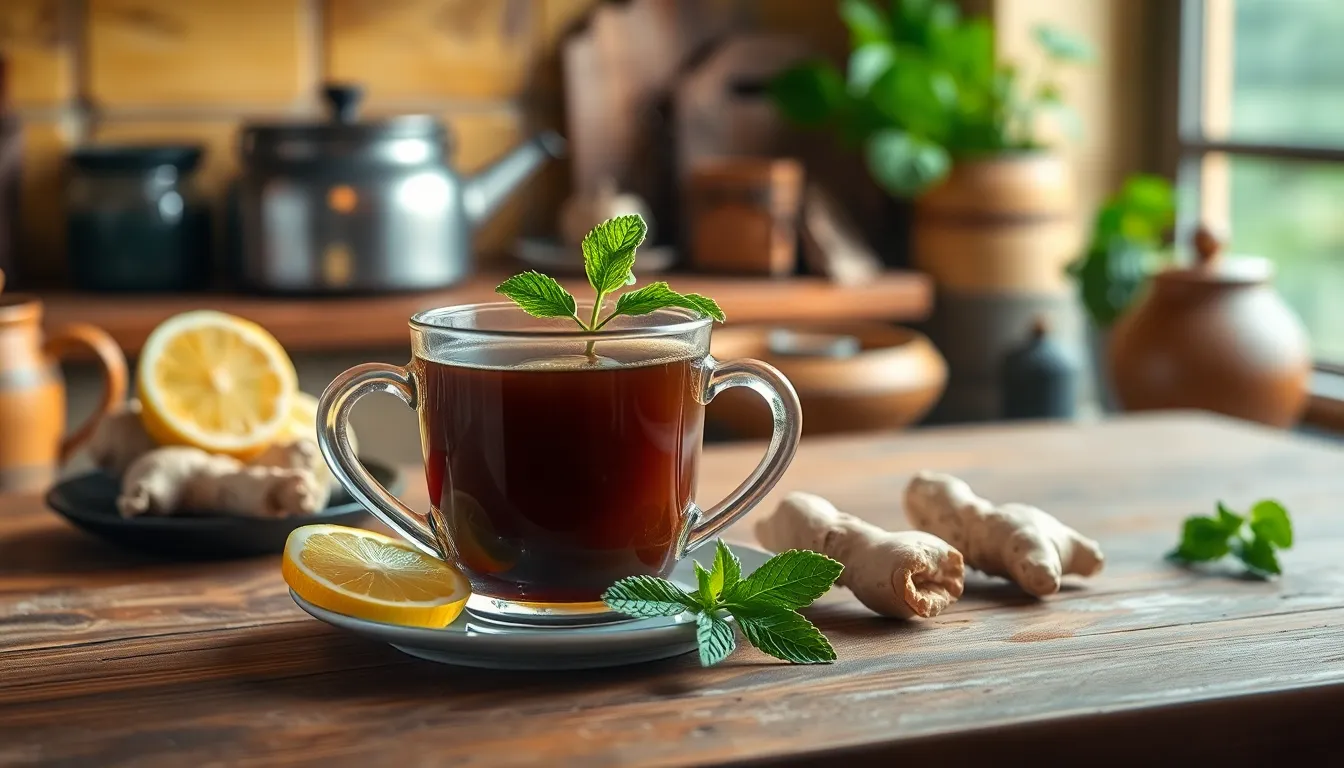
After mastering the traditional brewing method, we can explore countless ways to enhance yerba mate’s natural earthy flavor. These additions allow us to customize our brew while respecting the beverage’s authentic character.
Popular Flavor Combinations
We recommend starting with mint and citrus for a bright refreshing flavor that complements yerba mate’s grassy notes. Fresh mint leaves paired with a slice of lemon or orange peel creates an invigorating combination that many find irresistible.
Ginger and lemon add warmth and zest to our brewing experience. The spicy heat from fresh ginger root balances beautifully with tart lemon juice, creating a warming effect that energizes both body and mind.
Floral notes offer a sophisticated twist on traditional yerba mate. We can add chamomile flowers for a gentle honey-like sweetness or lavender buds for a calming aromatic experience that transforms our daily ritual.
Spiced mate brings comforting warmth to cooler days. Cinnamon sticks and whole cloves infuse our brew with warming spices that create a cozy atmosphere while maintaining yerba mate’s energizing properties.
Sweetening Options
Traditional preparation calls for unsweetened yerba mate, following the authentic practices common in Argentina and Uruguay. This approach allows us to fully appreciate the complex flavor profile that develops through multiple infusions.
Common sweeteners include sugar, honey, or agave syrup for those who prefer a gentler introduction to yerba mate. We add these sparingly to avoid overwhelming the subtle herbal notes that make this beverage unique.
Specialty blends offer convenient options for consistent sweetness. Pre-flavored yerba mate powders often contain stevia or artificial sweeteners, making them ideal for those seeking portion-controlled sweetening without the guesswork.
Storage and Maintenance
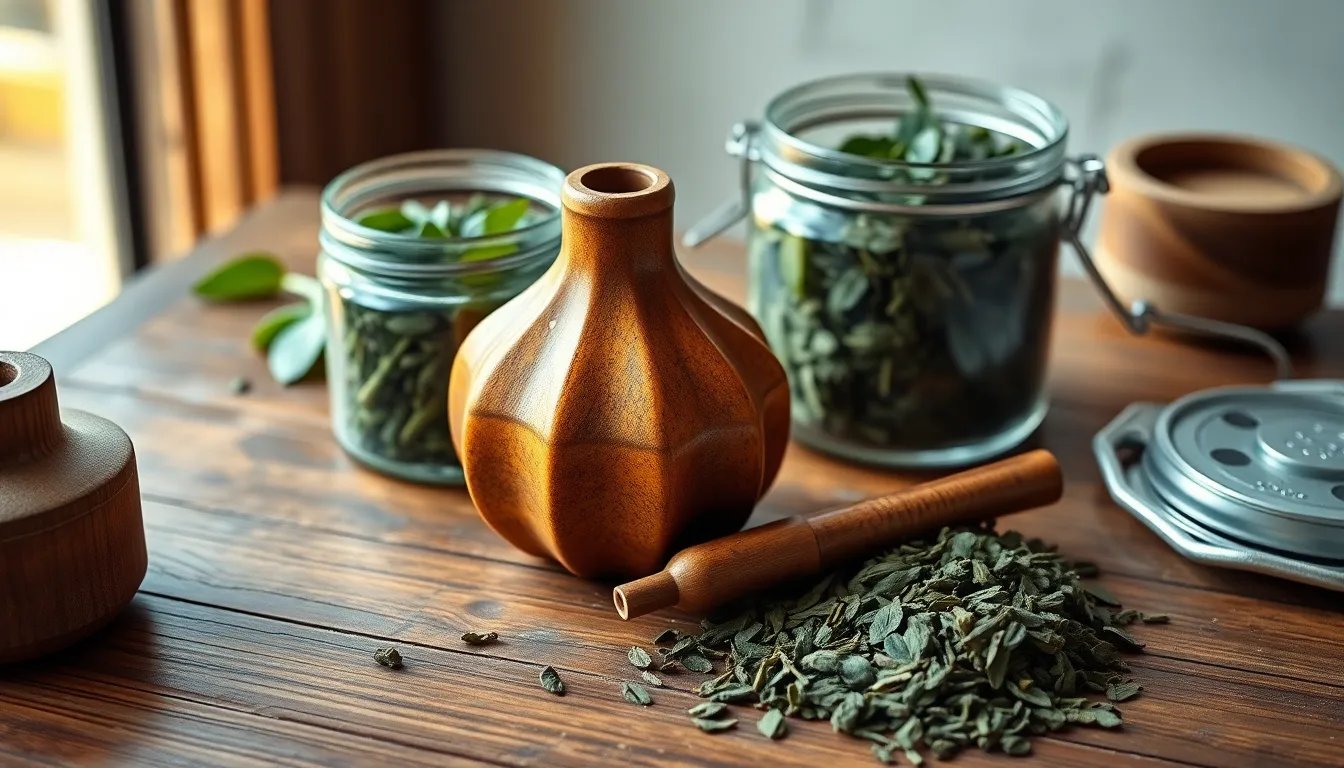
Proper storage and maintenance of your yerba mate and brewing equipment ensures optimal flavor and extends the life of your gourd and bombilla. Following these essential care practices will preserve the authentic taste and quality of your brewing experience.
Storing Your Yerba Mate
We recommend storing yerba mate in a cool, dry place within an airtight container to maintain freshness and prevent moisture absorption. Strong odors can easily penetrate the leaves, so keep your yerba mate away from spices, coffee, or other aromatic substances that might compromise its natural flavor profile.
Room temperature storage works best for yerba mate leaves. Refrigeration is not recommended for long-term storage as temperature fluctuations can affect the leaves’ quality and introduce unwanted moisture. Glass jars, sealed tins, or vacuum-sealed bags provide excellent protection against air exposure and humidity.
The original packaging often provides adequate protection if properly sealed after each use. Transfer your yerba mate to smaller containers as you consume it to minimize air exposure and maintain peak freshness throughout the package’s lifespan.
Caring for Your Gourd and Bombilla
We clean the gourd after each use by emptying all spent leaves and rinsing thoroughly with warm water. Soap should be avoided during regular cleaning as residues can affect the taste of future brews and interfere with the gourd’s natural seasoning.
Complete air drying prevents mold growth and maintains the gourd’s integrity. Place your gourd in a well-ventilated area and ensure it dries completely before storing to avoid moisture-related issues that can damage the natural material.
Hand-wash the bombilla with warm water immediately after each use to prevent residue buildup. A small brush effectively clears any particles from the filter without damaging the delicate screening mechanism.
Regular maintenance extends the life of both tools significantly. Inspect your bombilla periodically for clogs or damage, and gently clear any blockages with a thin brush or by soaking in warm water for deeper cleaning when necessary.
Troubleshooting Common Issues
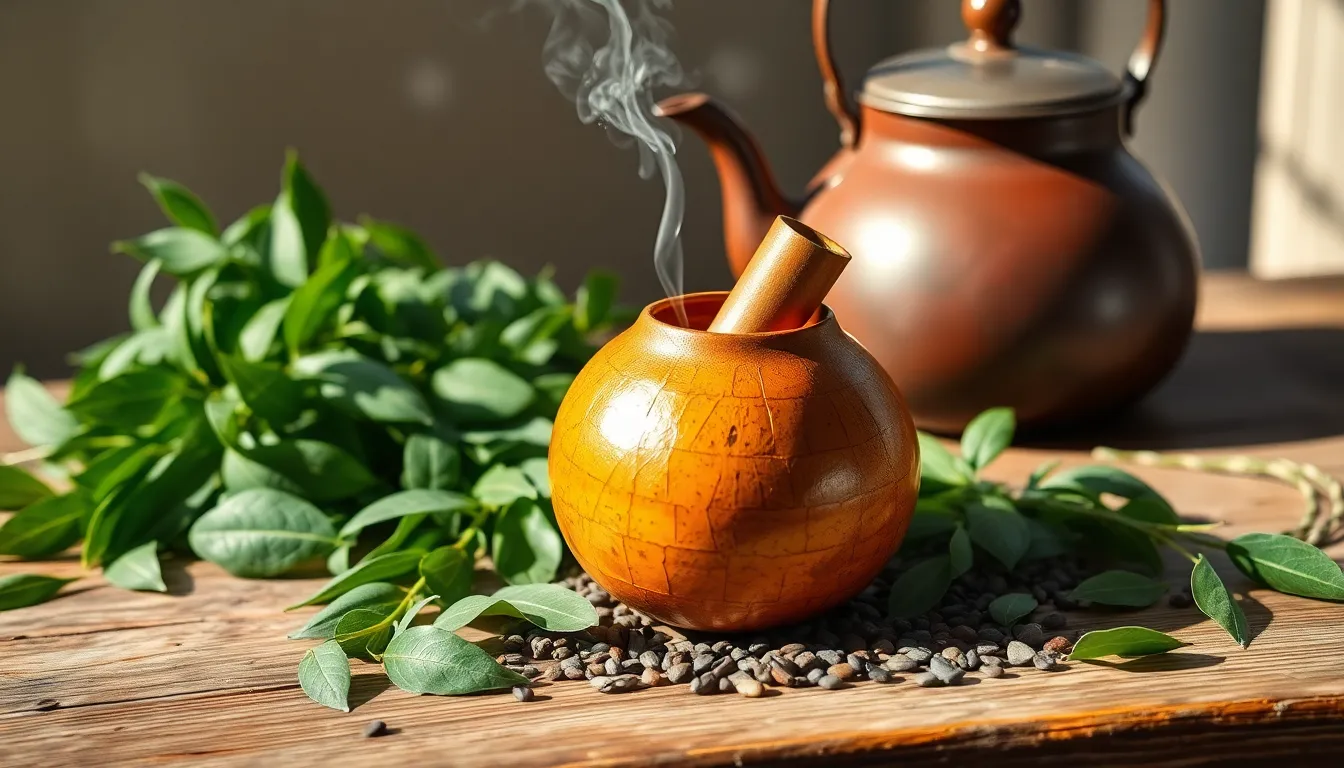
Even experienced yerba mate drinkers encounter brewing challenges from time to time. We’ll address the most common problems and provide proven answers to ensure every cup delivers the perfect balance of flavor and smoothness.
Fixing Bitter Tea
Water temperature stands as the primary culprit behind bitter yerba mate. We recommend maintaining water temperature between 158-176°F (70-80°C) to preserve the delicate flavor compounds without extracting harsh tannins. Boiling water destroys the tea’s natural sweetness and creates an unpleasantly bitter brew that even sweeteners cannot remedy.
Over-steeping presents another common mistake that leads to excessive bitterness. We suggest limiting initial steeping time to 3-5 minutes when using the teapot method. Traditional gourd preparation naturally prevents over-extraction since you sip continuously rather than allowing prolonged steeping.
Poor quality yerba mate or stale leaves contribute significantly to bitter flavors. We advise purchasing fresh yerba mate from reputable South American brands and storing it in airtight containers away from light and moisture. Fresh leaves should smell grassy and earthy rather than musty or flat.
Preventing Clogged Bombilla
Fine particles and dust create the most frequent bombilla blockages during brewing. We recommend shaking the gourd upside down before adding yerba mate to remove excess powder that settles at the bottom during packaging and storage. This simple step eliminates most clogging issues before they begin.
Gentle water pouring technique prevents fine particles from moving around and blocking the bombilla filter. We pour water slowly along one side of the gourd rather than directly onto the bombilla opening. This method maintains the yerba mate’s structure and keeps the drinking channel clear.
Proper bombilla insertion prevents many filtration problems. We insert the bombilla gently without pressing it deep into loose powdery yerba at the bottom of the gourd. The filter should rest lightly against the packed leaves rather than being forced into fine particles.
Regular bombilla maintenance ensures consistent performance throughout multiple brewing sessions. We rinse the bombilla with warm water after each use and occasionally perform deeper cleaning by soaking it in warm water for 10-15 minutes to remove accumulated residue from the filter holes.
Conclusion
We’ve covered everything you need to know about brewing authentic yerba mate tea from selecting the right equipment to mastering traditional techniques. Whether you choose the ceremonial gourd method or opt for modern alternatives like French press brewing you’re now equipped to enjoy this energizing South American beverage.
Remember that brewing yerba mate is both an art and a cultural experience. Take time to experiment with different temperatures steeping times and flavor additions to find your perfect cup. With proper storage and maintenance your gourd and bombilla will serve you well for years to come.
Start your yerba mate journey today and discover why millions of people across South America have made this remarkable tea part of their daily ritual. Your taste buds and energy levels will thank you for making the switch.
Frequently Asked Questions
What is yerba mate and where does it come from?
Yerba mate is a traditional South American tea enjoyed for centuries in Argentina, Uruguay, and Paraguay. It’s made from the leaves of the Ilex paraguariensis plant and provides sustained energy without the crash associated with coffee. Rich in vitamins, minerals, and antioxidants, yerba mate offers a healthier alternative to traditional caffeinated beverages while fostering cultural connection through its communal drinking traditions.
What equipment do I need to brew authentic yerba mate?
Essential equipment includes a gourd (mate cup) made from calabash, ceramic, or wood, and a bombilla (metal straw with a filter). You’ll also need a thermos to maintain water temperature and a thermometer to ensure water stays between 160-180°F. For beginners, ceramic or wooden gourds are recommended over traditional calabash gourds for easier maintenance.
How do I prepare a new gourd for first use?
Season a new gourd by filling it with loose yerba mate leaves and hot water, letting it sit overnight to create a concentrated infusion. Repeat this process for several days to build a protective layer that enhances future brews. This seasoning prevents the gourd from absorbing too much liquid and improves the overall flavor of your yerba mate.
What’s the correct water temperature for brewing yerba mate?
The optimal water temperature for yerba mate is between 158-176°F (70-80°C). Water that’s too hot will make the tea bitter and can damage the leaves through thermal shock. Using a thermometer ensures consistency, and maintaining this temperature range preserves yerba mate’s distinctive earthy flavor while maximizing its nutritional benefits.
How do I brew yerba mate using the traditional method?
Fill your gourd one-third with loose yerba mate leaves and tilt to create a slope. Pour cold water into the empty space to moisten leaves, then add hot water at 158-176°F. Insert the bombilla gently and sip. Refill with hot water multiple times to maintain flavor. The same leaves can be used for several rounds of brewing.
Can I brew yerba mate without traditional equipment?
Yes, you can use alternative methods like a French press, tea bags, or cold brewing. For French press, add yerba mate, moisten with cold water, then fill with hot water at 80-100°F. Tea bags can be steeped for 3-5 minutes. Cold brewing involves steeping loose leaves in cold water for 8-12 hours for a smooth concentrate.
What are the cultural customs around sharing yerba mate?
Yerba mate is traditionally a communal beverage shared in groups. The host prepares the gourd, takes the first sip, then passes it clockwise. Participants return the empty gourd to the host for refills. Important etiquette includes not moving the bombilla, not adding sugar without permission, and accepting the gourd when offered to show respect.
How can I customize the flavor of my yerba mate?
Popular additions include fresh mint and citrus for freshness, ginger and lemon for warmth, or floral notes like chamomile and lavender for sophistication. Spiced options with cinnamon and cloves create a warming experience. While traditionally unsweetened, you can add honey, sugar, or agave syrup. Specialty pre-flavored blends are also available for convenience.
How should I store yerba mate and maintain my equipment?
Store yerba mate in a cool, dry place in an airtight container like glass jars or sealed tins. Avoid refrigeration as it can cause moisture absorption. Clean your gourd after each use without soap, allowing it to air dry completely. Rinse the bombilla with warm water after use and occasionally soak for deeper cleaning to prevent clogs.
Why does my yerba mate taste bitter and how can I fix it?
Bitterness usually results from water that’s too hot (over 176°F) or over-steeping beyond 5 minutes. Use a thermometer to maintain proper temperature and limit steeping time. Ensure you’re using fresh, high-quality yerba mate stored properly. Stale leaves or poor storage can also contribute to bitter flavors. Check that your bombilla isn’t clogged, which can affect extraction.

